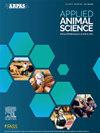Effects of spring and fall stockpile grazing management system on performance of fall-calving beef cows, preweaning calf performance, forage characteristics, and economics
IF 1.5
Q3 AGRICULTURE, DAIRY & ANIMAL SCIENCE
引用次数: 0
Abstract
Objective
The objective of this study was to compare the effects of tall fescue grazing systems using either rotational grazing only or rotational grazing and spring and fall stockpiling on beef cow body condition and reproductive performance, calf preweaning performance, forage characteristics, and system economics.
Materials and Methods
Over 2 yr, multiparous, fallcalving cows (n = 360 cows per year; 6 groups per year; BW = 600 ± 64 kg; gestation = 113 ± 9 d) were randomly assigned to 1 of 2 treatments: (1) rotational grazing only (CON) or (2) rotational grazing and spring and fall stockpile grazing (SP). Treatments were initiated in late April and terminated in late December each year. Pastures were 48.4 ha/replicate. Control pastures were divided into 8 (6.1 ha; rotated every 5 d) paddocks. Twenty-five percent of SP pastures (12.1 ha) were stockpiled for the initial 120 d, with the remaining 75% rotationally grazed (36.3 ha; rotated every 6–7 d). Starting in early August, 50% (24.2 ha) of the pasture was stockpiled. Strip-grazing (cows moved every 2–3 d) was used when grazing stockpiled forage in SP pastures. Cow BW and BCS were determined every 28 d, and forage characteristics were evaluated every 2 wk.
Results and Discussion
Cows grazed for 25 more days in SP compared with CON, resulting in a subsequent reduction of hay fed per cow in SP compared with CON (59 vs. 347 kg, respectively). Cow BW did not differ at trial end; however, BCS was greater in CON than in SP (5.3 vs. 5.1, respectively). No differences were observed in AI conception rate or overall pregnancy rate between treatments. There were no differences in calf birth BW or weaning BW between SP and CON. With an average hay price of $150/907 kg, breakeven urea price between treatments was $586.8/907 kg.
Implications and Applications
Grazing system type had minimal to no effects on cow and calf performance. Use of a spring and fall stockpiling system increased grazing days, reduced stored feed use, and could reduce winter feed costs.
春秋季散养放牧管理制度对秋产肉牛生产性能、断奶前犊牛生产性能、饲料特性及经济性的影响
本研究的目的是比较仅采用轮牧或轮牧及春秋两季堆放的高羊茅放牧系统对肉牛体况和繁殖性能、犊牛断奶前性能、牧草特性以及系统经济性的影响。材料与方法将2年以上的多胎产犊母牛(n = 360头/年;6组/年;体重 = 600 ± 64 kg;妊娠期 = 113 ± 9 d)随机分配到2个处理中的1个:(1) 仅轮牧 (CON) 或 (2) 轮牧和春秋两季堆放放牧 (SP)。处理于每年 4 月下旬开始,12 月下旬结束。牧场面积为 48.4 公顷/个重复。对照牧场分为 8 个(6.1 公顷;每 5 天轮牧一次)围场。25% 的 SP 牧场(12.1 公顷)在最初的 120 天内堆放,其余 75% 的牧场(36.3 公顷;每 6-7 天轮牧一次)进行轮牧。从 8 月初开始,50% 的草场(24.2 公顷)被堆放起来。在SP牧场放牧堆放的牧草时,采用带状放牧(奶牛每2-3天移动一次)。每28天测定一次奶牛体重和BCS,每2周评估一次牧草特性。结果与讨论与CON相比,SP牧场的奶牛放牧天数增加了25天,因此与CON相比,SP牧场每头奶牛的干草饲喂量减少了(分别为59千克和347千克)。试验结束时,奶牛体重没有差异;但是,CON的BCS高于SP(分别为5.3和5.1)。在人工授精受孕率和总妊娠率方面,各处理之间没有发现差异。SP 和 CON 在犊牛出生体重和断奶体重方面没有差异。在平均干草价格为 150 美元/907 千克的情况下,处理间尿素的盈亏平衡价格为 586.8 美元/907 千克。使用春秋两季堆放系统可增加放牧天数,减少贮存饲料的使用,并可降低冬季饲料成本。
本文章由计算机程序翻译,如有差异,请以英文原文为准。
求助全文
约1分钟内获得全文
求助全文

 求助内容:
求助内容: 应助结果提醒方式:
应助结果提醒方式:


